Odds & Ends: Ixalan, Part 1
Each set, I dedicate a column or two to my mailbag to see what you all want to know about the new set. As I write this column, the full Card Image Gallery was just released, so it's time to collect a whole bunch of questions and answer them.
Here's the tweet I put out:
It's time for the #mtgxln mailbag column. Send me a single tweet question about Ixalan. #WotCStaff
— Mark Rosewater (@maro254) September 15, 2017
As always, I try to answer as many questions as I can, but here's why I might not answer your question:
- I have an allotted word count, which means that there are only so many questions I can get to.
- Someone else might have asked the same question. I will usually answer the first person who asks.
- Some questions I either don't know the answer to or don't feel qualified enough in the area to properly answer them.
- Some topics I'm not allowed to answer for all sorts of reasons, including spoilers for future sets.
With that out of the way, let's get to the questions.
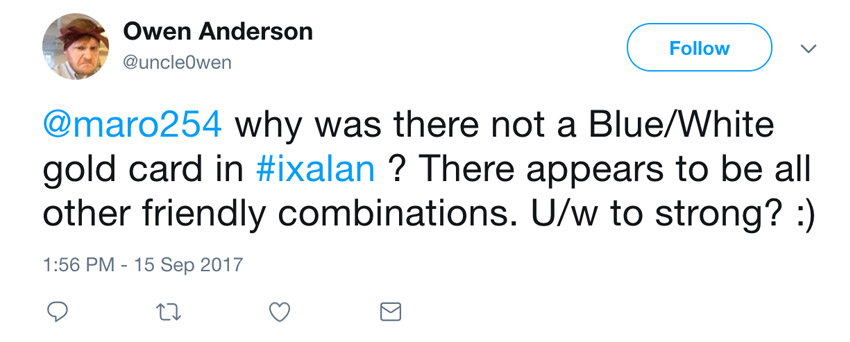
Because we had two large three-color factions (Pirates and Dinosaurs) and two small two-color factions (Vampires and Merfolk) in the set, we decided to center our multicolored cards around these factions. It turns out that eight of the two-color combinations correspond directly to a particular faction in Ixalan:
- White-black – Vampires
- Blue-black – Pirates
- Blue-red – Pirates
- Black-red – Pirates
- Red-green – Dinosaurs
- Red-white – Dinosaurs
- Green-white – Dinosaurs
- Green-blue – Merfolk
The two two-color pairs that don't have a corresponding faction are white-blue and black-green. We originally made uncommon multicolor cards for these two combinations, but as they weren't tied to the factions, they felt a little off, so we decided not to include them. We didn't want to confuse drafters who might choose to draft based on faction rather than color pairing. (Note that white-blue and black-green both have Draft themes, meaning that they can be drafted together synergistically, they just aren't tied together by any singular faction mechanics.)
Black-green did manage to get one card because Vraska is on Ixalan and she's a black-green character.
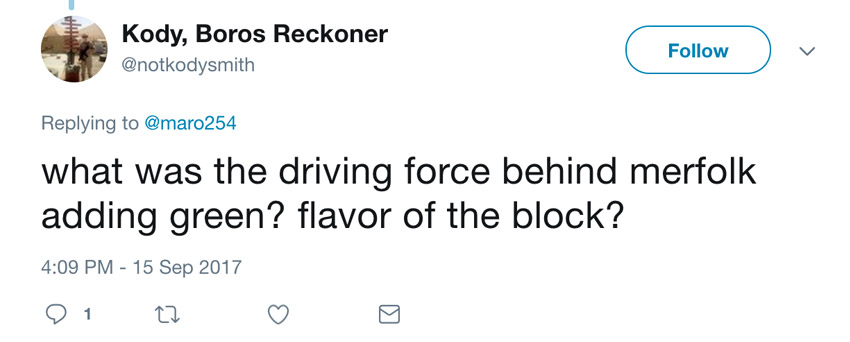
The process was a bit backward from the way you're imagining it. We didn't start with Merfolk tribal and then figure out what colors would be best. Instead, we had a green-blue faction and we looked for the best tribe to put there. The reason we had a green-blue faction was based on the other factions we wanted and what colors they felt best in. We knew when we chose Merfolk that it would be putting them into green, and it was a big discussion at the time. In the end, we decided that if we had a good creative reason for green Merfolk, the players would accept it.
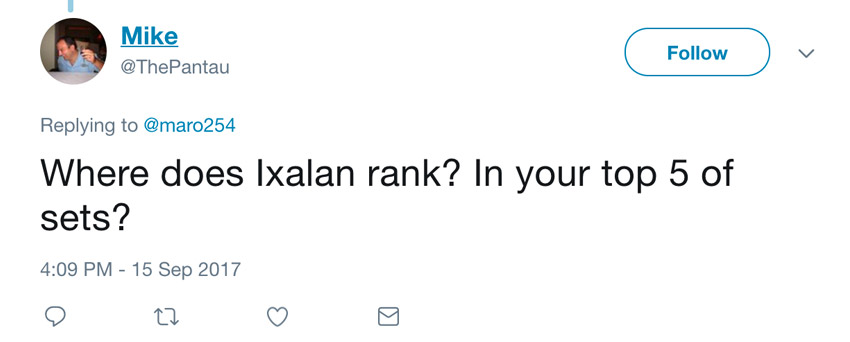
It's a little too early to grade Ixalan. A big part of how I evaluate sets has to do with how the set is received by the players. At the time of my writing this, you all haven't even played with the cards yet, so I'm going to have to hold judgment until I get a sense of how you all feel. I will say, so far, the response to the cards has been very positive.
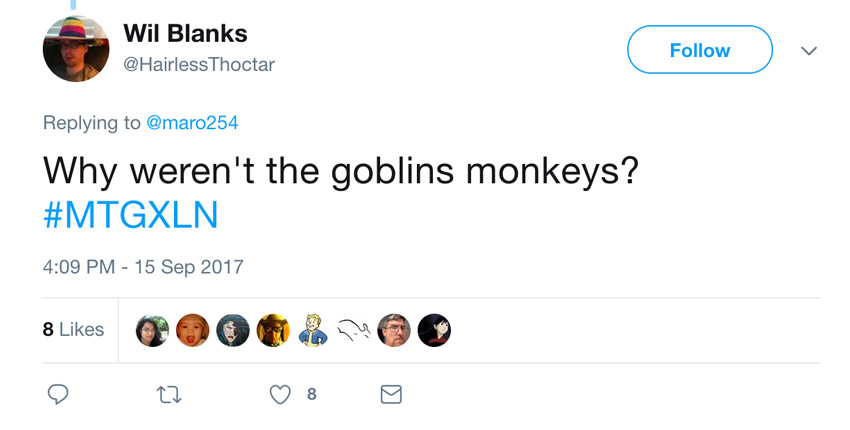
I actually brought this up because the Goblins in Ixalan do look like Monkeys. We talked about it, but in the end decided that they weren't actually Monkeys and calling them so in the creature type felt factually incorrect.
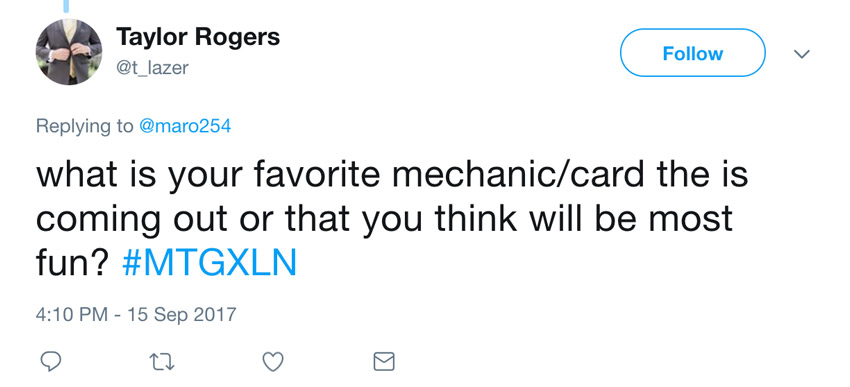
Enrage is the mechanic I'm most intrigued by. I think raid is an excellent mechanic, one I expect we'll get a lot of use of over the years, but it's a little more of a workhorse mechanic than a splashy mechanic. Enrage is the kind of thing that sets off my Johnny sensibilities, as it's something you can build around in interesting ways. I want to note that I do like explore. I just wish there were a way for it to be a little less wordy. (There isn't; I just wish there were.)
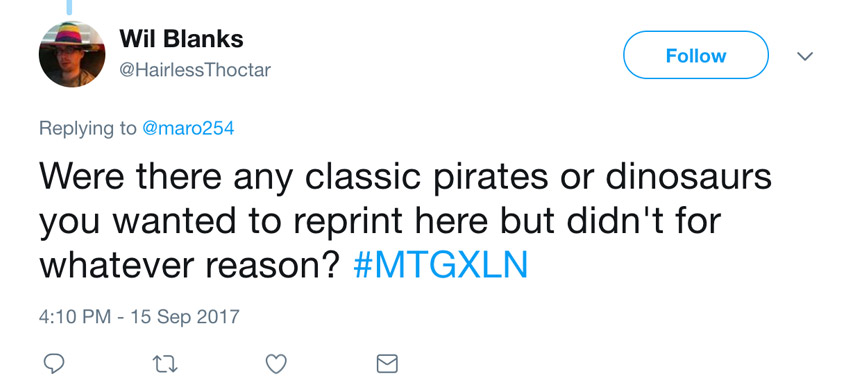
One of the reasons I was excited to do Pirates and Dinosaurs was because they were creature types we've never really done justice to. That meant, though, that there weren't many exciting things to bring back, either. We did look, but no Pirate or Dinosaur reprints ever made it into the file.

I don't know. That really isn't an area where I put my focus. The Play Design team needs to care about all the various formats to make sure we're creating the right cards, but that happens long after I've handed off the set. My goal with Ixalan, for example, was to create a vision for what the focus of the set was going to be, what would make players excited for the set. The focus on Pirates and Dinosaurs and the structure of the four factions—that's me and my team. The power level, the balance, even a majority of the mechanics came after the design handoff.
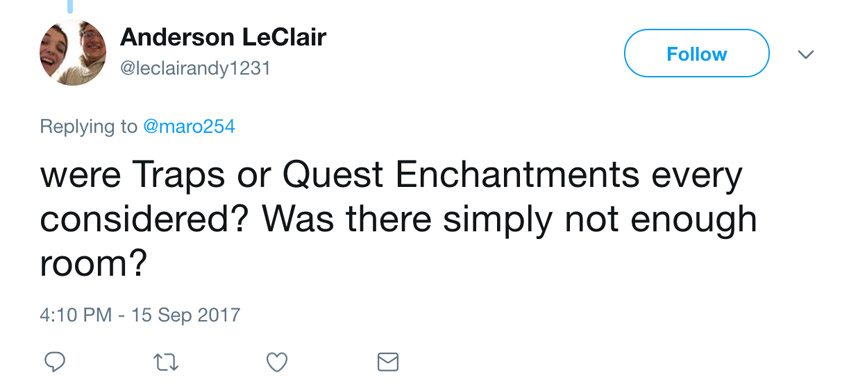
One of our big concerns about Ixalan was we wanted to make sure that it stayed distinct from Zendikar. Adventure World and Age of Exploration World could blur if we weren't careful, so we took great care to put a distance between things that were iconically Zendikar and Ixalan, two of those being Traps and Quests.
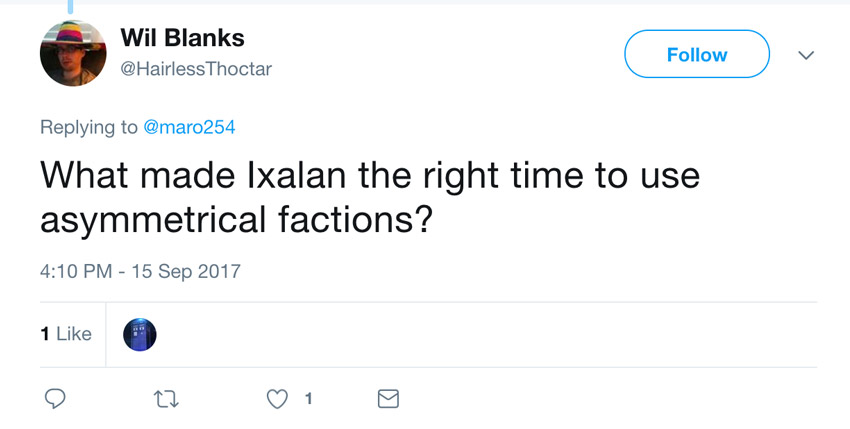
One of the things I always try to do in design is to understand what the needs of the set are. Ixalan was tricky because when we started, it wasn't exactly clear what the set was about. The more I played with it, the more I realized that it wanted to be a tribal set. The creative aspects lent themselves toward players building decks around the various factions, each of which was defined by a creature type. When I figured this out, the set had three factions, and it was quickly apparent that three wasn't enough.
So, why didn't I go to five? It was a subtle but important reason. Whenever a set goes to five colors, it starts to revolve around the color wheel. The number five is so intrinsic to the color pie that there's no way to separate it from color definition. For example, we color-balance our sets. There are as many white cards as blue ones (with the one exception being at mythic rare, where we occasionally are off by a card or two). This means when we create factions, we have to balance the colors across the factions. With five factions, we end up with either five one-color factions, five two-color factions, five three-color factions or five four-color factions. Once you do that, the colors start to pull focus. It's an arc set or a wedge set or a four-color set and not a tribal set.
Add to this that I'd already asked the creative team to add a faction (we started with a two-sided conflict), so I was hesitant to ask for too much more. I knew I could make tribal work with four factions. The big question though was then how to color-balance the set. In this case, I had a problem I'd solved once before back in Khans of Tarkir design. (That set started with four factions, before the Sultai Brood was added later in design.) It required having asymmetrical factions. It wasn't so much that I felt this was the right time for such an innovation as much as it was the clearest answer to my problem.
I'd been wanting to try an asymmetrical faction mix since Khans of Tarkir, but as with anything that doesn't make it through the process, I've learned to be patient until the proper opportunity comes along. The added thing that made this the right call was that I had a mix of factions where I purposely wanted to make the focus on two of them stronger than the rest. Yes, Vampires and Merfolk were cool, and I knew there would be players who would like them, but neither had the panache of Pirates or Dinosaurs, two tribes that players had been begging us for for years.
So why here, why now? Because it solved the problem in the most elegant way.
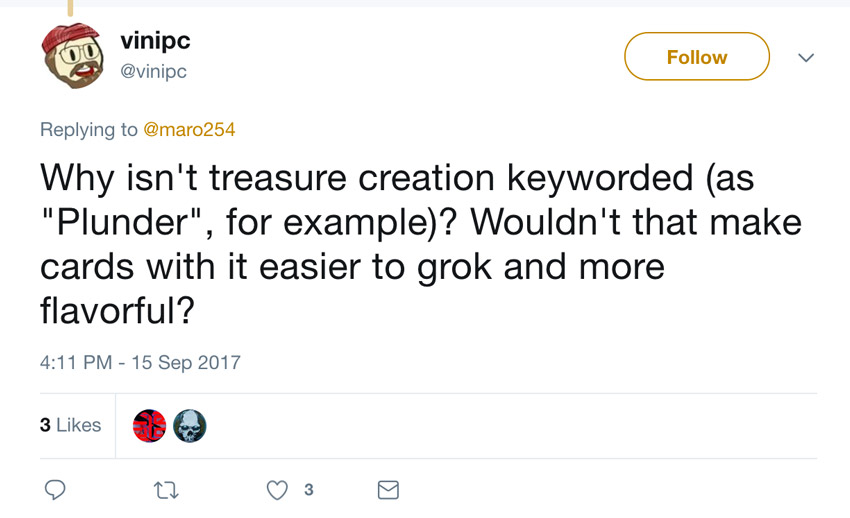
We normally don't keyword token-creation. The choice to do it in Shadows over Innistrad with investigate was because of a need in that set. Remember that investigate started doing something completely different, and when it changed over to making a token, we opted to keep the keyword because we needed to convey the flavor of solving a mystery—something that the story required that the rest of the set wasn't communicating well. (The design was more about everyone going mad.) Ixalan was in a very different place. Treasure tokens, especially in a set about Pirates, were flavorful in a vacuum and didn't require the help of a keyword for explanation.
As a general rule of thumb, we prefer when the name of the token can carry the burden of providing the flavor, because adding a keyword to its creation adds a lot of extra text on the cards. With Treasure, a keyword just wasn't necessary.
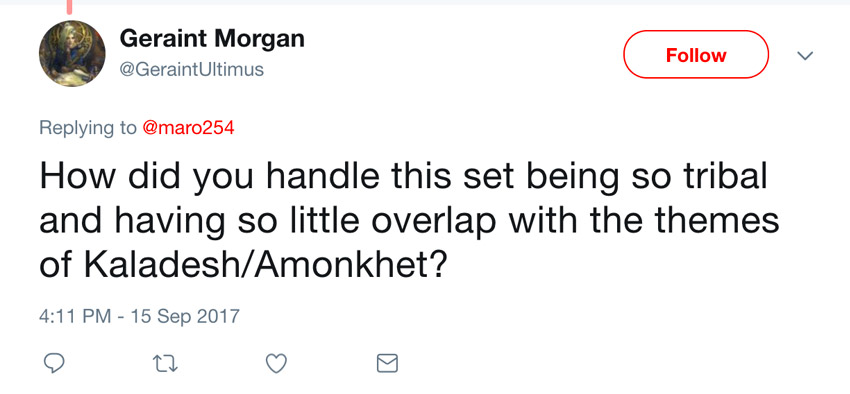
This was a big problem for the development of the set. Normally, when we do a tribal set, we try to make sure the sets around it have some overlap. However, Ixalan didn't start as a tribal set, so we didn't do the normal pre-seeding of creature types. In addition, both creature types we were focusing on—Pirates and Dinosaurs—were essentially new and not things we could easily stick in sets without drawing attention to them. They also were very exact creature types, making them an odd fit for a lot of worlds. We did manage to create two Pirates in Kaladesh block, Kari Zev, Skyship Raider and Skyship Plunderer, but that was about the best we could do.
In retrospect, we would have tried to craft worlds around it that would have helped us a little more, but we found some other tricks to help. For example, we can look at the archetypes supported by each of the new tribes and then makes sure we make cards that fit the deck, which we can then pre-seed in sets that come before. It's a bit more subtle, and requires extra work on our end, but it did allow us to have some solutions.
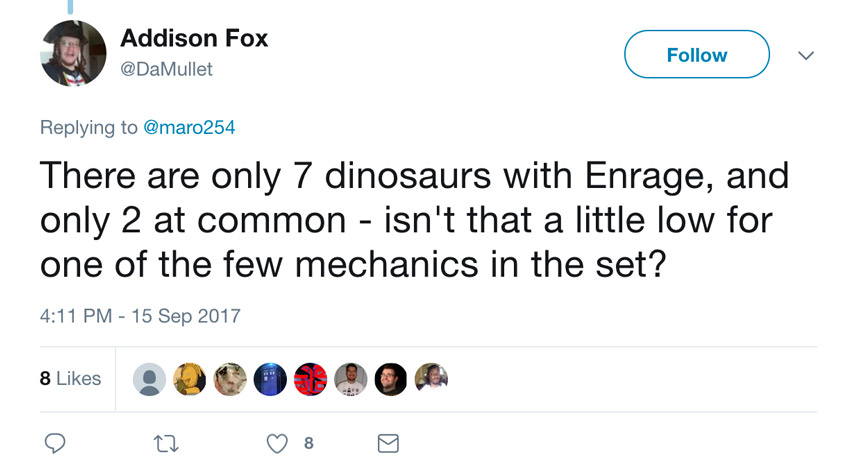
Here's Magic Design 101: never make more of something than the design of that thing can support. Yes, nine cards is on the lower end for a named mechanic, but it's well within the range we allow. In general, we tend to cap new keywords at a minimum of five cards. The reason most of them aren't at common is that enrage is just not a common-friendly mechanic. We usually tend to put repeatable effects, especially ones that allow for card advantage, at uncommon and higher.

No, we knew very early that the double-faced cards had a simple formula for Ixalan: You have the means to search for a special land, and eventually you find it. At no time during design or development did the double-faced cards have anything but a land on back.
We did, however, go through a period early on where there was a land on front and back. Here's how it worked. You played the land and then you needed to claim it. Once you did, the land transformed into the more powerful version. To claim it, you had to tap a number of creatures equal to a certain combined power. You might say that it sounds a bit like Vehicles. Well, it was. You see, at the time, the way crew worked was that it had a number and you tapped that many creatures to crew a Vehicle.
This implementation was causing the Kaladesh design team problems. We had come up with our version trying to stay away from how Vehicles worked. Once I realized that our solution might work for Vehicles, I talked to Ian Duke and Erik Lauer, the co-lead developers of Kaladesh, and offered up our variant. They tried it out, and it worked wonderfully, so they changed Vehicles to that system. That meant we had to scrap our double-faced lands and find a new way to execute them, which led us to the current version.
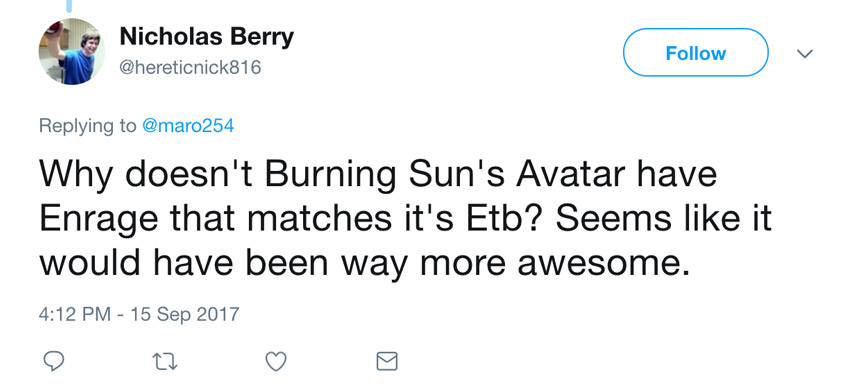
Two reasons:
- It would probably be too powerful, and
- I doubt all that text would fit on the card.
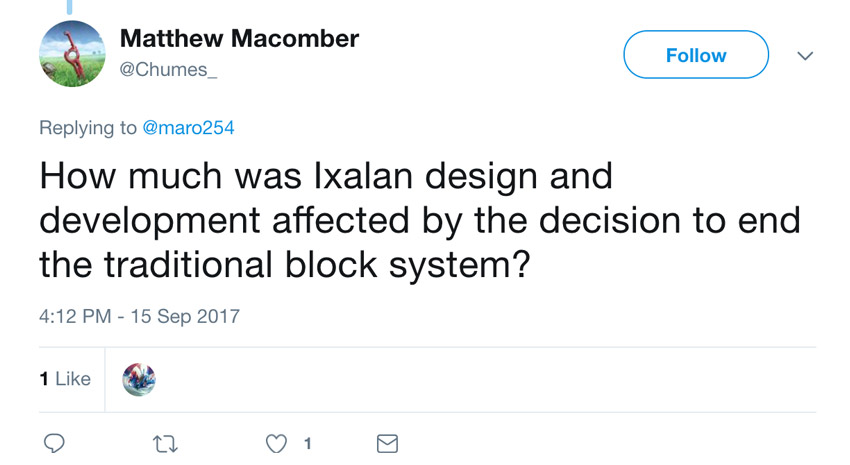
I can't speak for the development, but the design wasn't affected by the change at all—it happened after the design handoff to development.
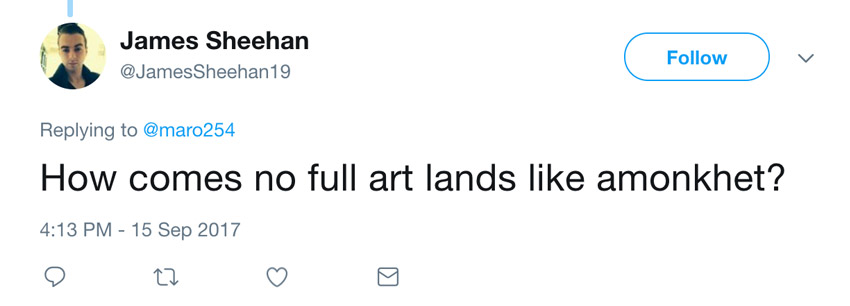
One of the big challenges of making a trading-card game is that you're constantly on the hook to create new content, and not just any content, but exciting content. Some of how we do this is the constant exploration of new design space. Another is finding things that players liked before and bringing those things back. This is a tricky proposition, though. Don't do it enough and not enough players remember it to want it to return. Do it too often and you diminish excitement.
Our goal with full-art lands is to do them often enough to create excitement, but infrequently enough that players don't grow tired off them. It's still a balance we're trying to figure out. The biggest reason Ixalan doesn't have full-art lands, though, is that there was already a product coming out in the second half of 2017 that would have them. I'm of course talking about Unstable.
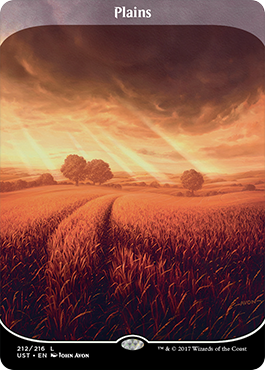
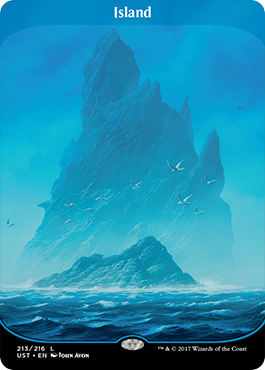
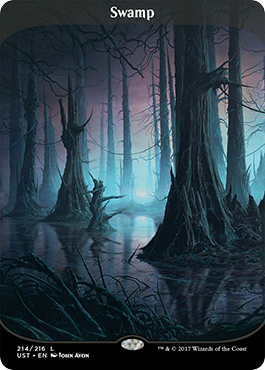
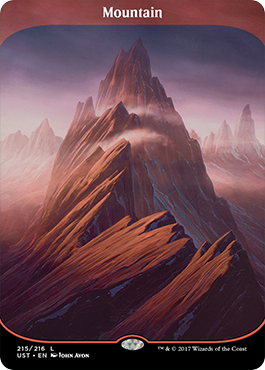
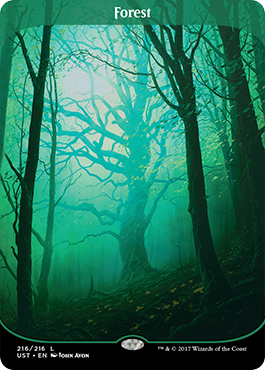
Illustrated by John Avon, these five basic lands are the first borderless lands ever made. The Un- sets premiered the full-art lands, and full-art lands have appeared in both Unglued and Unhinged, so we felt it was something players would expect from the product. This meant they weren't a good fit for Ixalan.
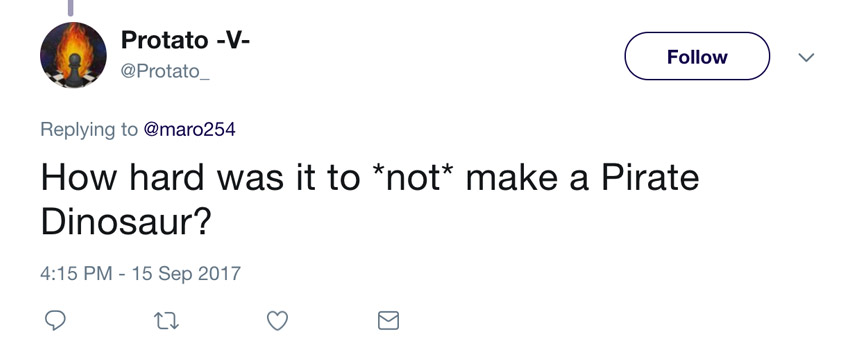
One of the questions I've been getting a lot on my blog is "Why didn't you make a [Ixalan Tribe] [Ixalan Tribe]?" The most popular request is Dinosaur Pirate (I put Pirate second because it's a class), but I've gotten all six combinations. Why didn't we do that?
First off, only three are even possible if we stick to the tribal color definitions—a red Dinosaur Pirate, a black Vampire Pirate, and a green Merfolk Dinosaur. The first and the third don't make any realistic sense, leaving only Vampire Pirate as a possible tribal overlap. The reason we didn't do it is we preferred clean definitions between our tribes. Having only four tribes also meant we had the numbers such that we didn't need to double up creature types to make it work. (Lorwyn, for example, had to use the Changeling keyword to have the numbers it needed to make individuals tribes work in Limited.)
Perhaps one day, now that Pirate and Dinosaur are more established, we'll find creative reasons to cross them with other tribes, but Ixalan wasn't the place we wanted to do that. For what it's worth, if Unstable had been designed later such that we knew of Ixalan during its design (remember the crux of Unstable design was in 2012 through 2014), I would have been very tempted to make a Dinosaur Pirate.
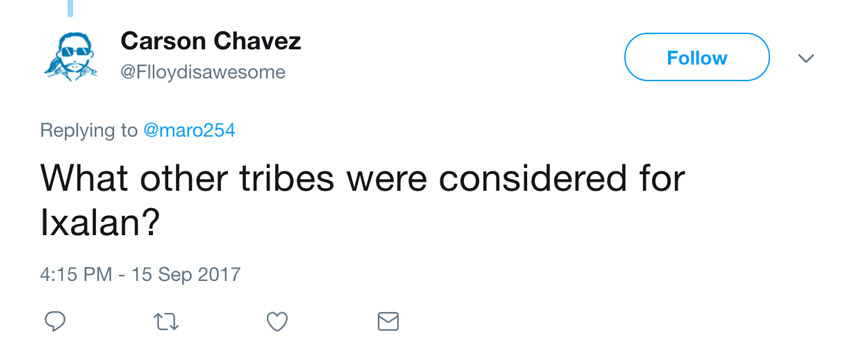
The Vampires were always Vampires and the Pirates were always Pirates. The red-green-white faction was Warriors before they started riding Dinosaurs, and the green-blue clan was Shaman before becoming Dinosaurs and eventually Merfolk. All in all, there wasn't that much shifting of creature types.
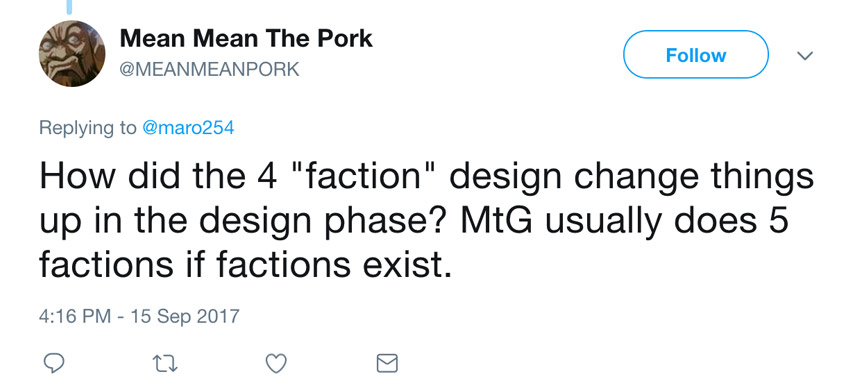
The uneven four-faction design had all sorts of implications on design and development. For starters, the three-color tribes had three two-color options in Draft, while the two-color tribes only had one. This forced us to design three different Draft archetypes for Pirates and Dinosaurs. We color-balanced tribes by color (black had the same number of Vampires as Pirates, for instance), but Pirates and Dinosaurs ended up with more overall cards as they were in an extra color each. It also messed with numerous systems we have in place to understand balance, as the systems assumed an equal weight for each faction.
Probably the biggest impact is a perceptual one. Normally, when we make factions, we treat them the same. For this set, that simply wasn't the case. Pirates and Dinosaurs were higher profile than Vampires and Merfolk. As those two were the new tribes, we knew they would get the lion's share of the attention, and that was okay. In fact, that was a big reason why we chose to have asymmetric factions; we wanted more focus on the two tribes we felt had the bigger splash.
"No More Questions"
That's all the time I have for today. I have a lot of questions left, so we'll have to get to them next week. As always, I'm eager for your feedback on any of my answers. You can email me your feedback or contact me through any of my social media accounts (Twitter, Tumblr, Google+, and Instagram).
Join me next week when I answer more questions.
Until then, may your tribe always be plentiful.
#476: Hour of Devastation
#476: Hour of Devastation
27:00
In this podcast, I talk all about the design of Hour of Devastation.
#477: Topical Blend
#477: Topical Blend
30:25
In my "Making Magic" column, I occasionally write articles where I blend together Magic and non-Magic topics selected by the audience. In this podcast, I talk all about the articles I've written in this format.
- Episode 475 Giving Input (18.8 MB)
- Episode 474 Keeping Things Different (24.6 MB)
- Episode 473 Gavin Verhey (4.6 MB)

